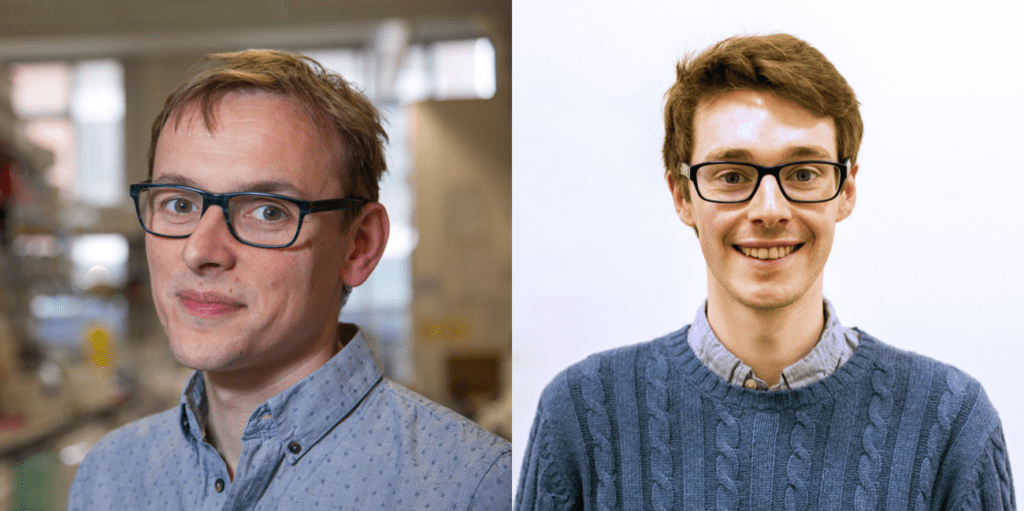Turning back the molecular clock: Tracing cell lineage
Q&A with Trevor Graham and Calum Gabbutt
Researchers from Barts Cancer Institute (BCI) at Queen Mary University of London, the Moffitt Cancer Center and the University of Southern California, have developed a new method that measures subtle changes to the genetic code of cells (called DNA methylation) to study the dynamics of what happens to cells within our bodies over time. The new method, published in Nature Biotechnology, provides a way to measure the birth and death of human cells, making it possible to trace cell lineage and evolution.

We recently spoke with BCI’s Professor Trevor Graham, who led the research at BCI, and PhD student Calum Gabbutt, who is first author of the study, about how the method could help us understand how our bodies work and how cancerous cells arise.
The research was primarily supported by funding from the BBSRC London Interdisciplinary Doctoral Programme, National Institutes of Health and Cancer Research UK.
Why is it useful to be able to trace cell lineage and evolution?
Trillions of cells make up the human body, and each day billions of these cells die and are replaced. In general, our bodies are maintained by a relatively small number of stem cells, which divide to produce billions of new cells every day.
Each time our cells divide, there is a chance that they will acquire one or more changes to their genetic code (known as mutations). As we age, our cells accrue a number of mutations and the DNA patterns of unrelated cells become increasingly different. Our bodies are therefore a patchwork of populations of different cellular clones, each derived from a distinct ancestor stem cell.
Surprisingly, recent work has shown that normal, healthy cells often harbour specific “driver” mutations found in cancer cells, that we had previously assumed were exclusive to cancer. The ability to trace how populations of cellular clones evolve over time offers an important step in understanding how these “cancer-primed” cells may outcompete their neighbours and eventually transform into cancer.
Could you tell us about the new method? How does it work?
It’s not possible to directly measure in humans how new cells arise – for obvious reasons we can’t have a microscope inside a living person’s body 24/7 – and tissue samples that are collected during surgery provide only a ‘snapshot’ of the tissue at that specific time. So it’s difficult to look backwards or forwards in time to see when and where cells are born and die.
We realised that subtle patterns exist in the genetic code of cells, where an “accent” is added to the C letter of the genetic code. These accents are called DNA methylation. The pattern of DNA methylation encodes the ancestry between cells: For example, two cells with the same DNA methylation pattern probably came from the same parent cell, whereas two cells with very different DNA methylation patterns likely shared a common ancestor a long time ago.
By developing a mathematical model of the DNA methylation patterns in cells, we found that the patterns can be used as “molecular clocks” to trace cell birth and death over time. The measurement of the patterns provides a powerful tool for quantifying cell evolution in human tissues, and we now have a general method we can apply to different tissues to understand how the cells in the body behave.
How could this method be useful for studying cancer?
One of the interesting phenomena that inspired the work is that cancers of the small bowel are rare and diagnosed in approximately 1,700 people per year in the UK. By comparison, cancer of the large bowel is diagnosed in around 42,300 people each year1. We hypothesised that this difference in cancer rate could be due to different numbers of stem cells in the small bowel versus the large bowel, with more stem cells dividing more rapidly carrying a higher risk of progressing to cancer. We decided to investigate this idea with our new method.
To our surprise, we did not detect a large difference in the number of stem cells between the small and large bowel and how they divide, suggesting that the huge difference in cancer incidence is probably not because of differences in stem cell behaviour.
As well as uncovering the clonal dynamics of normal tissue, we have demonstrated that our method is also applicable to various blood cancers. In our paper, computer modelling showed that slow growing blood cancers generate a different methylation signal to rapidly growing ones. We think that in the future we will be able to use our method to measure how cancers have grown and therefore predict how they will grow next, enabling us to pre-emptively select the most effective treatment for the patient. This approach, therefore, offers an exciting route towards more personalised cancer treatments.
Finally, we also think our method could be useful for the early detection of cancers. We can use our tool to detect if healthy-looking cells are actually growing unusually, and this could be an early warning that a cancer is likely to develop.
1Cancer Research UK https://www.cancerresearchuk.org/about-cancer/small-bowel-cancer/about - Accessed December 2021
More information
- Research publication: Gabbutt, C., Schenck, R.O., Weisenberger, D.J. et al. Fluctuating methylation clocks for cell lineage tracing at high temporal resolution in human tissues. Nat Biotechnol (2022). https://doi.org/10.1038/s41587-021-01109-w
Category: General News, Interviews, Publications

No comments yet